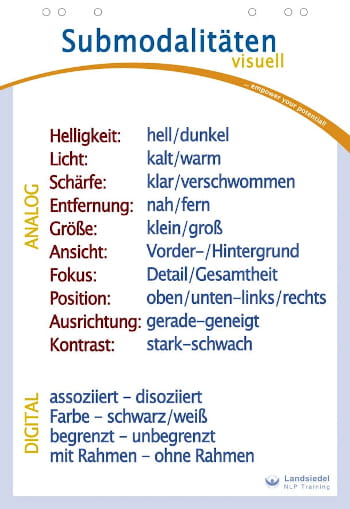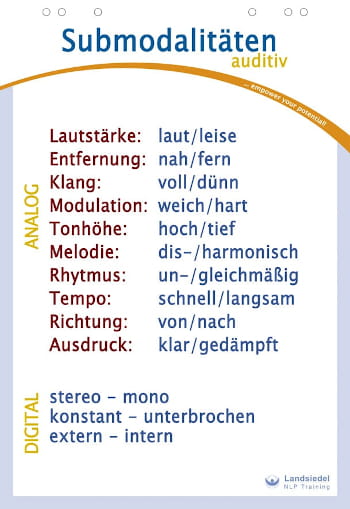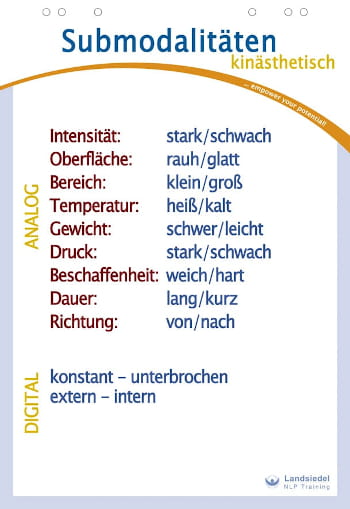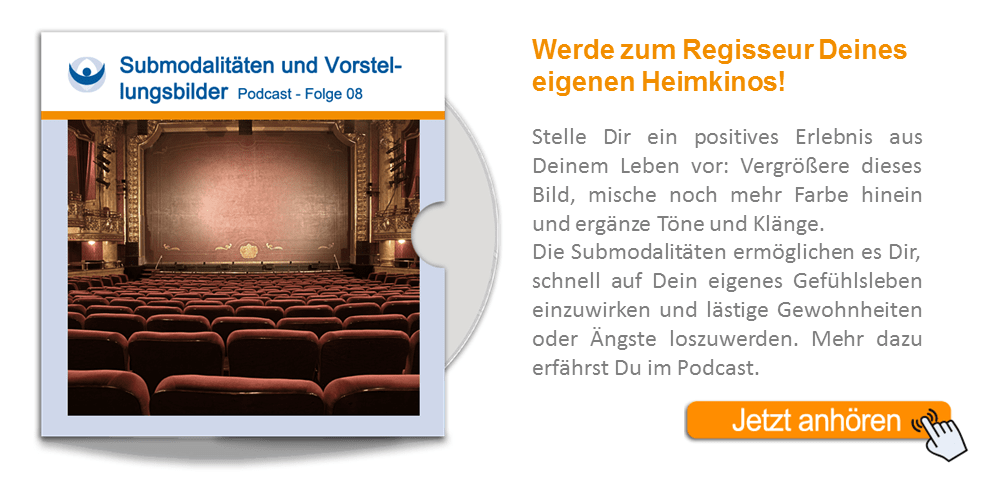Submodalities
Discover the programming language of subjective experience with this NLP technique. This powerful tool allows you to quickly influence emotions and eliminate unwanted habits or fears.
Introduction
This section explains what submodalities are and why they are important to understand.
Information about the world reaches us through our five senses, summarized as VAKOG. These senses are also referred to as modalities.
Submodalities are the finer distinctions within each sense — the smallest building blocks of subjective experience. For example, in the visual system: bright–dark, color–black and white, sharp–blurry; in the auditory system: loud–quiet, high–low, clear–muffled, etc. Every picture, sound, or feeling can be described using many submodalities.
The fascinating discovery in NLP is that changes in submodalities often have a stronger impact than changes in content. In other words, our emotions and body sensations depend more on *how* we represent something internally than on *what* we represent. This realization led Bandler and others to develop extremely effective and rapid intervention techniques.
Modalities = Representational Systems (VAKOG) | |
| Visual | Seeing |
| Auditory | Hearing |
| Kinesthetic | Feeling |
| Olfactory | Smelling |
| Gustatory | Tasting |
⇩
Submodalities = Fine distinctions within the senses Sensory encoding of experience | ||
| Visual | bright–dark | near–far |
| Auditory | loud–quiet | high–low |
| Kinesthetic | warm–cold | hard–soft |
| Olfactory | pleasant | unpleasant |
| Gustatory | sweet–sour | fruity–bitter |
⇩
Meta-Feelings = the emotional evaluation of sensory-coded experience |
Verbal Indicators of Submodalities
Submodalities often appear in language patterns. Examples include:
- I have a blurry picture of my future.
- He has a bright future ahead of him.
- His past is shrouded in darkness.
- I’m feeling blue.
- That leaves me cold.
- That really fires me up.
- That’s close to my heart.
Checklist of Possible Sensory Submodalities
A collection of submodalities for each sense.
Visual Submodalities

- Movie/Still: Is it a moving image or a still picture?
- Color/Black & White: Is it in color or black and white?
- Position: Where is the image — right, left, or center?
- Brightness: Is it bright, dim, or dark?
- Size: Life-sized, larger, or smaller?
- Distance: How close or far is it?
- Speed: Moving fast or slow?
- Perspective: Are you in the image or observing from outside?
- Frame: Does it have a frame or is it panoramic?
- Depth: 3D or 2D?
Auditory Submodalities

- Self/Others: Do you hear your own voice or someone else’s?
- Volume: How loud or soft is it?
- Pitch: High or low?
- Tone: What is the tone like?
- Speed: Fast or slow?
- Location: Where does the sound come from?
- Harmony: Is it harmonious or dissonant?
- Rhythm: Regular or irregular?
Kinesthetic Submodalities

- Temperature: Warm or cold?
- Texture: Smooth or rough?
- Pressure: Strong or light?
- Movement: Direction and intensity?
- Weight: Heavy or light?
- Tension: Tight or relaxed?
Exercises
The power of submodalities can only be experienced through practice. Try these exercises to explore them further.
Destruction of Images
Disturbing inner pictures can be transformed or destroyed to reduce their emotional intensity. Learn more: Destruction of Images.
Destruction of Auditory Representations
Everyone has inner voices that are not always kind. With these techniques, you can transform them in a playful way. Learn more: Destruction of Auditory Representations.
The Praline Pattern
A pattern for turning something you dislike but must do into something more motivating. Learn more: The Praline Pattern.
Changing a Belief
A strategy to replace limiting beliefs with empowering ones. Learn more: Changing a Belief.
Fear Opponent
With this technique, you can shrink your fear opponent until it loses its intimidating effect.
Swish Technique
The Swish Technique helps you eliminate bad habits and build strong positive motivation.
Learn more about submodalities in the online seminar recording with our trainer Ralf Stumpf:
Continue reading:

 Deutsch
Deutsch English
English Français
Français 中文
中文 Español
Español नहीं
नहीं Русский
Русский

